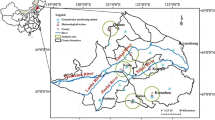Abstract
Quantitative agricultural landscape indices are useful to describe functional relationships among climatic conditions, groundwater dynamics, soil properties and agricultural land use for mathematical models. We applied methods of regression statistics, variance component estimation and a Geographical Information System (GIS) to construct indices describing crops and soils and to establish functional relationships among these variables. This paper describes the development of indices and the partitioning of the spatial and temporal variation in groundwater models using the data from Tulare County, California, which was selected as the study area. Indices of ground surface elevation, total crop water demand, soil water infiltration rate, and soil production index explain 91% of the variation in average spring groundwater level. After relating spatial patterns of groundwater use to indices of crop and soil properties, we found that mean groundwater use is positively related to total crop water demand and soil water infiltration rate while the variation in groundwater use was negatively correlated with the crop water demand and soil water infiltration rate and positively related to soil water holding capacity. The spatial variation in groundwater use was largely influenced by crops and soil types while the temporal variation was not. We also found that groundwater use increased exponentially with decreasing annual precipitation for most townships. Based on these associations, groundwater use in each township can be forecast from relative precipitation under current methods of agricultural production. Although groundwater table depth is strongly affected by topography, the statistically significant indices observed in the model clearly show that agricultural land use influences groundwater table depth. These simple relationships can be used by agronomists to make water management decisions and to design alternative cropping systems to sustain agricultural production during periods of surface water shortages.
Similar content being viewed by others
References
Almekinders, C.J.M., L.O. Fresco and P.C. Struik, 1995. The need to study and manage variation in agro-ecosystems. Netherlands J Agricultural Science 43: 127–142.
Andersson, L. and A. Sivertun, 1991.A GIS-supported method for detecting the hydrological mosaic and the role of man as a hydrological factor. Landscape Ecology 5: 107–124.
Barringer, J.L., R.L. Uley and G.R. Kish, 1987. A methodology for relating regions of corrosive ground water to hydrogeologic variables in the New Jersey Coastal Plain. International Geographic Information Systems Symposium 3: 73–86.
Boone, R.L., M.E. Campana and C.M. Skau, 1983. Relationships among precipitation, snowmelt, subsurface flow, groundwater recharge and streamflow generation in the clear creek watershed, Eastern Sierra Nevada. Water Resources Center, Desert Research Institute, University of Nevada System. Publication No. 41084.
California Department of Water Resources. 1974. Tulare county land and water resources. San Joaquin District.
California Department of Water Resources. 1991. California's continuing drought 1987–1991, a summary of impacts and conditions as of December 1, 1991. Drought Information Center. Sacramento.
Costanza, R., F.H. Sklar and J.W. Day, Jr., 1986. Modeling spatial and temporal succession in the Atchafalaya/Terrebonne march/estuarine complex in south Louisiana. In Estuarine Variability. pp. 387–494. Edited by D.A. Wolfe. Academic Press, New York.
Curtis, L. 1988. Water resources in Tulare county. County Report.
Draper, N.R. and H. Smith, 1981. Applied regression analysis. Wiley, New York.
ESRI (Environmental Systems Research Institute). 1990. ARC/INFO GIS Products. Redlands, CA.
Frenzel, S.A. 1985. Comparison of methods for estimating ground water pumpage for irrigation. Ground Water 23(2): 220–226.
Gleick, P.H. and L. Nash, 1991. The societal and environmental costs of the continuing California drought. Research Report, Pacific Institute for Studies in Development, Environment, and Security.
Gustafson, E.J. and G.R. Parker, 1992. Relationships between landcover proportion and indices of landscape spatial pattern. Landscape Ecology 7(2): 101–110.
Howitt, R. and M. M'Mareta, 1991. 'Well set aside' proposal: a scenario for ground water banking. California Agriculture 45(3): 6–9.
Hulshoff, R.M. 1995. Landscape indices describing a Dutch landscape. Landscape Ecology 10: 101–111.
Levin, S.A. 1992. The problem of pattern and scale in ecology. Ecology 73: 1943–1967.
Medley, K.E., B.W. Okey, G.W. Barrett, M.F. Lucas and W.H. Renwick, 1995. Landscape change with agricultural intensification in a rural watershed, southwestern Ohio, U.S.A. Landscape Ecology 10: 161–176.
Myers, R.H. 1987. Classical and modern regression with applications. pp. 317–318. Duxbury Press, Boston.
O'Neill, R.V., J.R. Krummel, R.H. Garder, G. Sugihara, B. Jackson, D.L. DeAngelis, B.T. Milne, M.G. Turner, B. Zygmunt, S.W. Charistensen, V.H. Dale and R.L. Graham, 1988. Indices of landscape pattern. Landscape Ecology 1(3): 143–162.
Pierce, L.L. and S.W. Running, 1995. The effects of aggregating sub-grid land surface variation on large-scale estimates of net primary production. Landscape Ecology 10: 239–253.
Riitters, K.H., R.V. O'Neill, C.T. Hunsaker, J.D. Wickhan, D.H. Yankee, S.P. Timmins, K.B. Jones and B.L. Jackson, 1995. A factor analysis of landscape pattern and structure metrics. Landscape Ecology 10: 23–39.
Risser, P.G. 1987. Landscape Ecology, State of the Art. In Landscape Heterogeneity and Disturbance. pp. 3–14. Edited by M.G. Turner. Springer-Verlag, New York.
Roe, H.B. 1950. Moisture requirements in agriculture – farm irrigation. McGraw-Hill Book Company, Inc. New York.
Rousseeuw, P.J. and A.M. Leroy, 1987 Robust Regression and Outlier Detection. John Wiley & Sons, New York.
Ryszkowski, L. and A. Kedzoira, 1987. Impact of agricultural structure on energy flow and water cycling. Landscape Ecology 1: 85–94.
Schmidt, K.D. and I. Sherman, 1987. Effect of irrigation on groundwater quality in California. Journal of Irrigation and Drainage Engineering 113(1): 16–29.
Tan, Y.R. and S.F. Shih, 1990. GIS in monitoring agricultural land use changes and well assessment. St. Joseph, ML: Trans. American Society of Agricultural Engineers 33(4): 1147–1152.
Tulare County, 1990. Agricultural annual report. Agricultural Commissioner's Office. Visalia.
University of California Cooperative Extension, 1990. Crop evapotranspiration leaflet. Department of Land, Air and Water Resources, University of California Davis.
U.S. Geological Survey Report, 1970. Land subsidence, 1962–1970, Hanford-Tulare-Wasco Area.
Water Resources Center, University of Minnesota, 1983. Groundwater recharge rates inMinnesota as related to precipitation. Report, Project No. B–153.
Author information
Authors and Affiliations
Rights and permissions
About this article
Cite this article
Zhang, M., Geng, S. & Ustin, S.L. Quantifying the agricultural landscape and assessing spatio-temporal patterns of precipitation and groundwater use. Landscape Ecology 13, 37–54 (1998). https://doi.org/10.1023/A:1007924914662
Issue Date:
DOI: https://doi.org/10.1023/A:1007924914662




